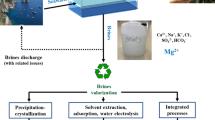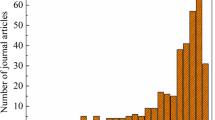Abstract
Spontaneous imbibition and core flooding investigations were carried out on limestone core plug samples using different low salinity water (LSW) and smart brines at temperatures of 110 and 50℃, respectively. To demonstrate further the potential of low salinity water injection (LSWI) as an agent for enhanced oil recovery (EOR) studies, the interfacial tension (IFT), contact angle (CA), and zeta potential (ZP) were measured. The recovery factor values provided from spontaneous imbibition experiments investigated by formation water (FW), seawater (SW), dilution versions of SW (i.e., 1/2SW, 1/10SW) were 10.07, 15.11, 18.05, and 16.04%, respectively. However, the secondary LSW flooding produced more oil, i.e., a higher recovery factor (37.3, 55, and 61% for FW, SW, and 1/10SW, respectively). The recovery factor obtained from LSW flooding at the tertiary state for SW, 1/2SW, and 1/10SW brines increased up to 11.86, 12.67, and zero, respectively. The main conclusions of the work were as follows. (1) The results of secondary spontaneous imbibition tests showed that LSWI had a significant potential to mobilize the trapped oil. (2) During secondary and tertiary core flooding, the maximum oil recovery (78% of OOIP) was achieved during smart water flooding when the amount of \({\text{SO}}_{4}^{2 - }\) ion was increased and inactive ions (\({\text{Na}}^{ + }\) and \({\text{Cl}}^{ - }\)) were eliminated. (3) LSWI and smart water showed significant effects on relative permeability curves, which are indicative of wettability alteration. (4) The main driving mechanism for oil mobilization was found to be wettability alteration, which was supported by the analyses of CA and ZP.










Similar content being viewed by others
Data Availability
The data presented in this study are available on request from the corresponding author.
Notes
* 1 cp (centipoise) = 0.001 kg/(m·s).
*1 md = 1 millidarcy = 9.86923 × 10−16 m.2.
References
Abbasi, S., Tavakkolian, M., & Shahrabadi, A. (2012). An experimental study of the effect of the water injection process on rock structure and permeability reduction. Journal Petroleum Science and Technology, 30(7), 685–698.
Alotaibi, M. B., Nasralla, R. A., & Nasr-El-Din, H. A. (2010). Wettability challenges in carbonate reservoirs. In: SPE Improved Oil Recovery Symposium.
Al-Saedi, H. N., & Flori, R. E. (2018). Enhanced oil recovery of low salinity water flooding in sandstone and the role of clay. Petroleum Exploration and Development, 45(5), 927–931.
Austad, T., Strand, S., Høgnesen, E. J., & Zhang, P. (2005). Seawater as IOR Fluid in Fractured Chalk. In: SPE International Symposium on Oilfield Chemistry.
Austad, T., RezaeiDoust, A., & Puntervold, T. (2010). Chemical mechanism of low salinity water flooding in sandstone reservoirs. In: SPE Improved Oil Recovery Symposium.
Austad, T., Shariatpanahi, S. F., Strand, S., Black, C. J. J., & Webb, K. J. (2012). Conditions for a low-salinity enhanced oil recovery (EOR) effect in carbonate oil reservoirs. Energy & Fuels, 26(1), 569–575.
Austad, T., Strand, S., Madland, M. V., Puntervold, T., & Korsnes, R. I. (2008). Seawater in Chalk: An EOR and compaction fluid. SPE Reservoir Evaluation & Engineering, 11(04), 648–654.
Bartels, W. B., Mahani, H., Berg, S., & Hassanizadeh, S. M. (2019). Literature review of low salinity waterflooding from a length and time scale perspective. Fuel, 236, 338–353.
Cuiec, L. (1984). Rock/Crude-Oil interactions and wettability: An attempt to understand their interrelation. In: SPE Annual Technical Conference and Exhibition
Derkani, M. H., Fletcher, A. J., Abdallah, W., Sauerer, B., Anderson, J., & Zhang, Z. J. (2018). Low salinity waterflooding in carbonate reservoirs: review of interfacial mechanisms. Colloids and Interfaces, 2(2), 20.
Esene, C., Rezaei, N., Aborig, A., & Zendehboudi, S. (2019). Comprehensive review of carbonated water injection for enhanced oil recovery. Fuel, 237, 1086–1107.
Heggheim, T., Madland, M. V., Risnes, R., & Austad, T. (2005). A chemical induced enhanced weakening of chalk by seawater. Journal of Petroleum Science and Engineering, 46(3), 171–184.
Hiorth, A., Cathles, L. M., & Madland, M. V. (2010). The Impact of pore water chemistry on carbonate surface charge and oil wettability. Transport in Porous Media, 85(1), 1–21.
Katende, A., & Sagala, F. (2019). A critical review of low salinity water flooding: Mechanism, laboratory and field application. Journal of Molecular Liquids, 278, 627–649.
Lager, A., Webb, K. J., Black, C. J. J., Singleton, M., & Sorbie, K. S. (2008). Low salinity oil recovery - An experimental investigation1. Petrophysics - The SPWLA Journal of Formation Evaluation and Reservoir Description, 49(01).
Ligthelm, D. J., Gronsveld, J., Hofman, J., Brussee, N., Marcelis, F., & van der Linde, H. (2009). Novel waterflooding strategy by manipulation of injection brine composition. In: EUROPEC/EAGE Conference and Exhibition.
Mahani, H., Keya, A. L., Berg, S., & Nasralla, R. (2016). Electrokinetics of Carbonate/Brine Interface in Low-Salinity Waterflooding: Effect of Brine Salinity, Composition, Rock Type, and pH on ?-Potential and a Surface-complexation model. SPE Journal, 22(01), 53–68.
McGuire, P. L., Chatham, J. R., Paskvan, F. K., Sommer, D. M., & Carini, F. H. (2005). Low salinity oil recovery: An exciting new EOR opportunity for Alaska's North Slope. SPE Western Regional Meeting.
Montazeri, M., Fazelabdolabadi, B., Shahrabadi, A., Nouralishahi, A., HallajiSani, A., & Moosavian, S. M. A. (2020). An experimental investigation of smart-water wettability alteration in carbonate rocks – oil recovery and temperature effects. Energy Sources, Part A: Recovery, Utilization, and Environmental Effects. https://doi.org/10.1080/15567036.2020.1759735
Montazeri, M., Shahrabadi, A., Nouralishahi, A., Mousavian, S. M., & Hallaj, A. (2018). Investigation of Wettability Alteration due to Smart Water Injection into Carbonate Reservoirs by Zeta Potential and Contact Angle’s Tests. Journal of Petroleum Research, 28(97–4), 29–39.
Morrow, N. R. (1979). Interplay of capillary, viscous and buoyancy forces in the mobilization of residual oil. Journal of Canadian Petroleum Technology. https://doi.org/10.2118/79-03-03
Nasralla, R. A., Alotaibi, M. B., & Nasr-El-Din, H. A. (2011). Efficiency of oil recovery by low salinity water flooding in sandstone reservoirs. In: SPE Western North American Region Meeting.
Nasralla, R. A., Mahani, H., van der Linde, H. A., Marcelis, F. H. M., Masalmeh, S. K., Sergienko, E., Brussee, N. J., Pieterse, S. G. J., & Basu, S. (2018). Low salinity waterflooding for a carbonate reservoir: Experimental evaluation and numerical interpretation. Journal of Petroleum Science and Engineering, 164, 640–654.
Nasralla, R. A., Sergienko, E., Masalmeh, S. K., van der Linde, H. A., Brussee, N. J., Mahani, H., Suijkerbuijk, B. M., & Al-Qarshubi, I. S. (2016). Potential of low-salinity waterflood to improve oil recovery in carbonates: demonstrating the effect by qualitative coreflood. SPE Journal, 21(05), 1643–1654.
Rivet, S. M., Lake, L. W., & Pope, G. A. (2010). A coreflood investigation of low-salinity enhanced oil recovery. SPE Annual Technical Conference and Exhibition.
Romanuka, J., Hofman, J. P., Ligthelm, D. J., Suijkerbuijk, B. M., Marcelis, A. H., Oedai, S., Brussee, N. J., van der Linde, A., Aksulu, H., & Austad, T. (2012). Low salinity EOR in Carbonates. SPE Improved Oil Recovery Symposium.
Roostaie, A., Golghanddashti, H., Abbasi, S., & Shahrabadi, A. (2016). An experimental investigation of different formation waters and injection water incompatibility to obtain the optimum water mixing ratio in injection processes. Journal of Petroleum Science and Technology, 1, 63–72.
Sorop, T. G., Masalmeh, S. K., Suijkerbuijk, B. M., van der Linde, H. A., Mahani, H., Brussee, N. J., Marcelis, F. A., & Coorn, A. (2015). Relative permeability measurements to quantify the low salinity flooding effect at field scale. In: Abu Dhabi International Petroleum Exhibition and Conference.
Tang, G.-Q., & Morrow, N. R. (1999). Influence of brine composition and fines migration on crude oil/brine/rock interactions and oil recovery. Journal of Petroleum Science and Engineering, 24(2), 99–111.
Treiber, L. E., & Owens, W. W. (1972). A laboratory evaluation of the wettability of Fifty Oil-producing reservoirs. Society of Petroleum Engineers Journal, 12(06), 531–540.
Yousef, A. A., Al-Saleh, S., Al-Kaabi, A., & Al-Jawfi, M. (2010). Laboratory investigation of novel oil recovery method for carbonate reservoirs. In: Canadian Unconventional Resources and International Petroleum Conference.
Yousef, A. A., Al-Saleh, S., Al-Kaabi, A., & Al-Jawfi, M. (2011). Laboratory investigation of the impact of injection-Water Salinity and ionic content on oil recovery from carbonate reservoirs. SPE Reservoir Evaluation & Engineering, 14(05), 578–593.
Zaeri, M. R., Hashemi, R., Shahverdi, H., & Sadeghi, M. (2018). Enhanced oil recovery from carbonate reservoirs by spontaneous imbibition of low salinity water. Petroleum Science, 15(3), 564–576.
Zhang, Y., & Morrow, N. R. (2006). Comparison of secondary and tertiary recovery with change in injection brine composition for crude-oil/sandstone combinations. In: SPE/DOE Symposium on Improved Oil Recovery. OnePetro, Tulsa, Oklahoma.
Zhang, P., & Austad, T. (2006). Wettability and oil recovery from carbonates: Effects of temperature and potential determining ions. Colloids and Surfaces A: Physicochemical and Engineering Aspects, 279(1), 179–187.
Zhang, P., Tweheyo, M. T., & Austad, T. (2006). Wettability Alteration and Improved Oil Recovery in Chalk: The effect of Calcium in the Presence of Sulfate. Energy & Fuels, 20(5), 2056–2062.
Zhang, P., Tweheyo, M. T., & Austad, T. (2007). Wettability alteration and improved oil recovery by spontaneous imbibition of seawater into chalk: Impact of the potential determining ions Ca2+, Mg2+, and SO42−. Colloids and Surfaces A: Physicochemical and Engineering Aspects, 301(1), 199–208.
Acknowledgments
The authors are immensely grateful to Prof. Andrew Binley (Lancaster University, UK) for carrying out an independent review of the manuscript.
Author information
Authors and Affiliations
Corresponding author
Ethics declarations
Conflict of Interest
The authors have no known conflicts of interest to declare associated with this publication.
Rights and permissions
About this article
Cite this article
Shahrabadi, A., Babakhani Dehkordi, P., Razavirad, F. et al. Enhanced Oil Recovery from a Carbonate Reservoir During Low Salinity Water Flooding: Spontaneous Imbibition and Core-Flood Methods. Nat Resour Res 31, 2995–3015 (2022). https://doi.org/10.1007/s11053-022-10092-1
Received:
Accepted:
Published:
Issue Date:
DOI: https://doi.org/10.1007/s11053-022-10092-1




